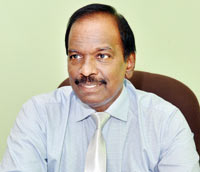Reading printed materials more ‘convenient’ than screens – SLAP President
View(s):
Veerasamy Kumaran
People find it more “convenient” to read printed materials rather than content from a screen, which is why millions of people have visited the international book fair at the BMICH to date, according to Veerasamy Kumaran, President of the Sri Lanka Assocition of Printers (SLAP).
He also added, “As I know, the newspaper readership is also higher now than in previous years. Perhaps Internet affected greeting card printing. I personally do not think this new trend is a major cause for alarm to the printing industry”.
Giving a history of his organisation, Mr. Kumaran noted that the SLAP “was set up in 1956 and we will be 60 next year. At the beginning the office was moved from place to place. The office functioned from the home of a printing press of one member to another with one month here and the next month in another place. After about 30 – 40 years from the inception the association became properly organised. The Finance Ministry started listening to our views for formaulation of the national budget with regard to the needs to develop the printing industry in relation to the impact on the progress and growth of the national economy. We managed to lobby many concessions for the industry to be competitive and benefit Sri Lankan manufacturers and exporters. The former presidents of our association managed to convince the government to remove customs duty from printing paper and up to now we enjoy this benefit”.
Commenting further, he indicated, “We understood the requirement of our own office and 17 of our members came forward to contribute Rs. 1 million each. We raised Rs. 35 million within one month, bought the land and commenced construction. Now we are in our own building. We have reached out to members and non-members in all 25 districts island-wide, to give all the facilities they require… We conduct a grand exhibition named ‘Collate’ every two years with the next one planned in March 2016. Many foreign suppliers take part in this exhibition enthusiastically. Our objective is to make this a meeting place for suppliers to the printing industry and the printers and expose them to new products, processes and modern efficient technologies”.
Adding to this, Mr. Kumaran revealed, “Even before the conflict came to an end we were conducting training workshops and seminars in affected areas. Recently we conducted a very successful seminar in the East with collaboration of the Export Development Board. The next one will be in Jaffna. We hold such seminars and workshops throughout the island. We will be working to develop training with special emphasis in the North- East”.
Heralding the next step for the local industry, Mr. Kumaran signalled, “digital technology is a must for the future of the printing industry. The demand of customer requirement in the printing industry varies. One customer may require 50 copies of something. If we are to print a smaller quantity in the conventional method the cost is very high. That is not valid anymore with digital printing. Now there are printers which do short runs at very reasonable and low prices using digital technology… We should be open to reach the international market and therefore get ready to supply the global requirements. We can do that only by marching forward armed with the new technology”. Asked why the younger generation is not attracted to the printing industry, Mr. Kumaran said:
“This is an abnormal situation. In western countries the children are trained to be independent by the time they reach the age of 16. The parents encourage children to shoulder responsibilities. Our children cannot even select a dress to wear at this age. When they reach 18 there is always friction between parents and children. The parents have not educated their children on important things in their life even by that time. The children get socially isolated. They come out of school living in an imaginary world. They do not know how to find a way to earn a living. The printing industry is an art. It requires skills as well as training to be a good printer. It can offer great opportunities to earn high income and to improve the quality of life. This is no more an ink and grease industry. We started the Sri Lanka Print Media Academy to train young people to take advantage of the many opportunities offered and available in this field. We have commenced several courses in the printing field”. (JH)


